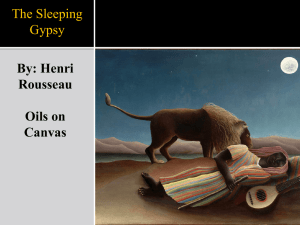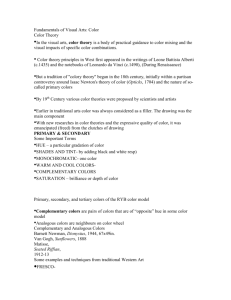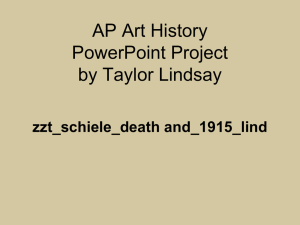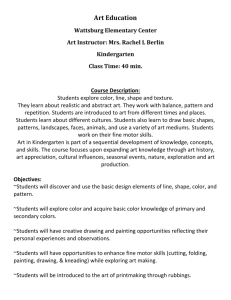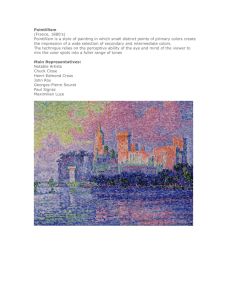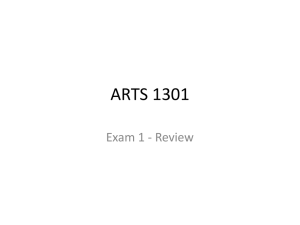Art History Timeline
advertisement
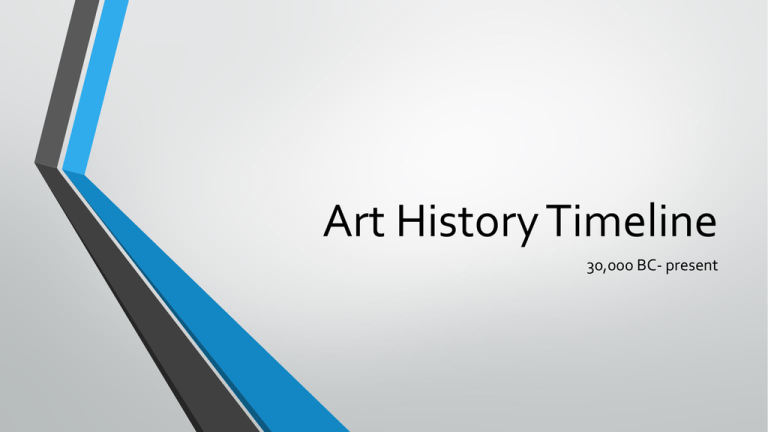
Art History Timeline 30,000 BC- present England Ireland Stone Age 30,000-10,000 b.c. • 40,000 years ago • Humans were hunter-gatherers– day revolved around food • Portable art- could take with them • Stationary art- cave walls, stayed forever • Art was about FOOD or FERTILITY • Artists unknown Egyptian 5,000 b.c.- 300 a.d. • Painting and sculpture • Symbolic: animals, colors, size • Emphasis on life after death • • • Classical Art’s main medium was sculpture Greek: Athletics, Mythology, Daily life, Doric/Ionic columns • • • Athens Most famous temple: Parthenon (dedicated to Athena) Perfection, balance, idealism Roman: Mythology, Real people, Historical events, Corinthian columns • • • Rome Most famous temple: Pantheon (dedicated to 7 gods) Practical, realism CLASSICAL ART Greek & Roman 1700-1400 b.c. Roman Art The Senate Ancient Ruins Sarcófago Ludovisi– The Battle of Rome Pantheon Colosseum Vatican City- St. Peter’s Basillica Asian 653 b.c-1900 a.d • • • • • • Chinese, Japanese, Indian Oldest and continuous kind of art– traditional Painting, sculpture, pottery, decorative arts Ceramic factories showed wealth and power of emperors (still have today) Serene, meditative art; Nature Ink on silk or paper Chinese Art Hanshan Temple- bell rings at Chinese New Year- there is one in Japan too Hanging Temple- for 3 religions: Buddhism, Confucianism, and Taoism Terracotta Soldiers– more than 7,000 total Buddha- Yungang Grottoesover 51,000 Buddha statues in this cave Byzantine a.d. 476-1853 • • • • • • • • Eastern Rome More abstract & symbolic than Roman art Flat or One-dimensional • • Why the change? Debate over whether there was a decline in artistic talent or if there was an oriental influence. Artists were members of the religious house Long, Narrow, Solemn faces– Bodies faced front Religion- icon image of Jesus Christ Dedication of Constantinople- capitol city, ruled by Constantine Illumination of biblical texts Ivory reliefs, no sculptures-- idolatry Byzantine Art San Vitale Basillica in Ravenna, Italy Mosaics Giunta Pisano, Crucifix in Bologna, Italy Islamic a.d. 476-1453 • Architecture, calligraphy, painting, glass, ceramics, textiles (rugs) • Maze-like designs, repeating elements- arabesques • • Only God is perfect Infinite and indivisible nature of God • People were not portrayed in art- idolizing • Secret miniatures • Architecture: Mosque, Tomb, Palace, Fort Middle Ages 500-1400 • • • Also known as the Dark Ages: decrease in prosperity, stability, and population Art was associated with churches because it was costly, so almost all art was religious Over 1,000 years of art in Europe; includes many major art movements: • • Romanesque: Piestic paintings- religious, large churches, no portraits, muted colors Gothic art: brighter colors, sculptures, realism, naturalism, stained glass, symmetry Middle Ages Art fresco Vaulted ceilings & Flying buttresses Renaissance 1400-1550 • • • • • • Rebirth of Classical traditions– but apply scientific advancements & religious changes Naturalism, 3D, lifelike “rescuing and restoring art” from the “crude Byzantine style” Anatomy & human emotion Themes: religious altar pieces, fresco cycles, and small works for private collections Techniques: perspective, foreshortening, sfumato, chiaroscuro, balance, proportion Renaissance Techniques foreshortening sfumato chiaroscuro Mannerism 1527-1580 • • • • • • Break rules Artifice over nature Intellectual sophistication Beautiful, “has style” Compositional tension & instability rather than balance & clarity of the Renaissance Elongated proportions, stylized poses, no clear perspective, theatrical lighting, strange settings Baroque 1600-1750 • • • • • Started by Catholic church- the arts should communicate religious themes Art as a weapon in the religious wars- church wanted to speak to the illiterate, not just the well informed To impress visitors– express triumph, power, & control The name was at first given as an insult– too many unnecessary details, noisy--translates to “elaborate” Exaggerated motion, clear details Wanderer above the Sea of Fog Sea of Ice, Wreck of Hope • • • • Romanticism 1780-1850 The Nightmare Liberty Leading the People Not love romance, but GLORIFICATION– glorified concepts such as liberty, survival, ideals, hope, awe, heroism, despair, and the various feelings that nature evokes in humans (views & sunsets) First start seeing feelings of the artist, not everyone feels the same Creation from nothingness– originality Characteristics: • • • • Emotional emphasis Nature can kill you (shipwrecks, lots of shipwrecks) Current events No exact style, technique, or subject matter The Raft of the Medusa The End of the Working Day Realism 1848-1900 • • • • • • Focus on every day life Represent art truthfully– portray exactly what they saw Rejected Romanticism– avoided over exaggerated emotionalism and drama, instead portrayed things as they really were with no emotions involved Included all classes of people in all aspects of life (even if it was ugly) Ordinary people in ordinary life Photography was introduced and became popular Bonjour, Monsiuer Corbet The Arnolfini Portrait Impressionism 1865-1885 • • • Began in Paris by a group of artists Haystacks Name comes from Monet’s painting, “Impression Sunrise” Characteristics • • • • • • • • • Small, thin, visible brushstrokes Ordinary subject matter Capturing effects of natural light & how it changes Unusual visual angles Movement Colors often aren’t mixed, instead laid side by side Avoids using black paint, grays (complimentary colors to shade) Didn’t wait for paint to dry Painted in evenings to create shadows & studied natural colors of light Lydia Leaning on Her Arms Post-Impressionism 1885-1910 • • • • • Continued impressionist style, but emphasized geometric forms Exaggerated an aspect of impressionism Impasto- thick application of paint– shows off texture and paint marks Used unnatural color Pointillism Fauvism 1900-1910 • Led by Matisse and Derain • Only had 3 exhibitions, lasted a short time • Wild brushstrokes • Strong color • Not realistic; abstract; simple • Color theory study Cubism 1905-1920 • • • • • Considered most influential movement of 20th century Objects are analyzed, broken up, and rearranged Many viewpoints instead of just one Abstract Inspired movements in other art forms (music, literature, theatre) • • • • • Painting dreams Surrealism 1917-1950 Exploring the unconscious– automatic writing Illogical scenes that looked realistic Made creatures out of every day objects Element of surprise Abstract Expressionism 1940-1960 • • • First American-only influenced movement-- NYC Spontaneous, automatic, subconscious “It’s better to catch the spirit of the sea, rather than all it’s tiny ripples.” Modernism 1960-present • • • • • • • • • Freedom of expression Experimentation Pop-Art Consumerism Radicalism Startled audiences Collage, installations “ready-mades” Performance art



